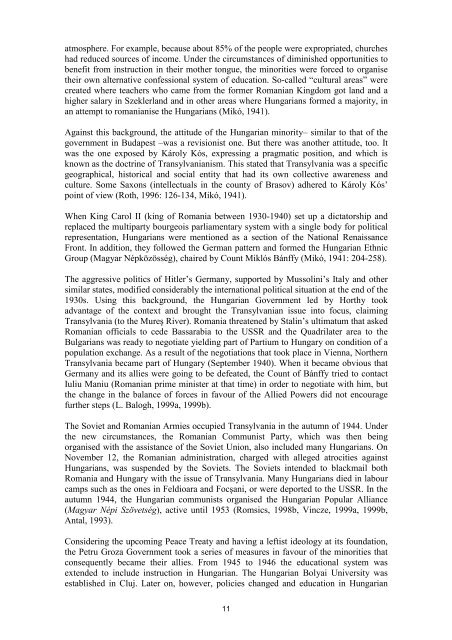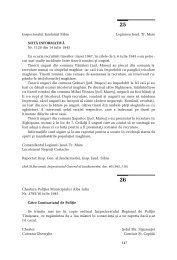Southeast Europe
Southeast Europe
Southeast Europe
Create successful ePaper yourself
Turn your PDF publications into a flip-book with our unique Google optimized e-Paper software.
atmosphere. For example, because about 85% of the people were expropriated, churches<br />
had reduced sources of income. Under the circumstances of diminished opportunities to<br />
benefit from instruction in their mother tongue, the minorities were forced to organise<br />
their own alternative confessional system of education. So-called “cultural areas” were<br />
created where teachers who came from the former Romanian Kingdom got land and a<br />
higher salary in Szeklerland and in other areas where Hungarians formed a majority, in<br />
an attempt to romanianise the Hungarians (Mikó, 1941).<br />
Against this background, the attitude of the Hungarian minority– similar to that of the<br />
government in Budapest –was a revisionist one. But there was another attitude, too. It<br />
was the one exposed by Károly Kós, expressing a pragmatic position, and which is<br />
known as the doctrine of Transylvanianism. This stated that Transylvania was a specific<br />
geographical, historical and social entity that had its own collective awareness and<br />
culture. Some Saxons (intellectuals in the county of Brasov) adhered to Károly Kós’<br />
point of view (Roth, 1996: 126-134, Mikó, 1941).<br />
When King Carol II (king of Romania between 1930-1940) set up a dictatorship and<br />
replaced the multiparty bourgeois parliamentary system with a single body for political<br />
representation, Hungarians were mentioned as a section of the National Renaissance<br />
Front. In addition, they followed the German pattern and formed the Hungarian Ethnic<br />
Group (Magyar Népközösség), chaired by Count Miklós Bánffy (Mikó, 1941: 204-258).<br />
The aggressive politics of Hitler’s Germany, supported by Mussolini’s Italy and other<br />
similar states, modified considerably the international political situation at the end of the<br />
1930s. Using this background, the Hungarian Government led by Horthy took<br />
advantage of the context and brought the Transylvanian issue into focus, claiming<br />
Transylvania (to the Mureş River). Romania threatened by Stalin’s ultimatum that asked<br />
Romanian officials to cede Bassarabia to the USSR and the Quadrilater area to the<br />
Bulgarians was ready to negotiate yielding part of Partium to Hungary on condition of a<br />
population exchange. As a result of the negotiations that took place in Vienna, Northern<br />
Transylvania became part of Hungary (September 1940). When it became obvious that<br />
Germany and its allies were going to be defeated, the Count of Bánffy tried to contact<br />
Iuliu Maniu (Romanian prime minister at that time) in order to negotiate with him, but<br />
the change in the balance of forces in favour of the Allied Powers did not encourage<br />
further steps (L. Balogh, 1999a, 1999b).<br />
The Soviet and Romanian Armies occupied Transylvania in the autumn of 1944. Under<br />
the new circumstances, the Romanian Communist Party, which was then being<br />
organised with the assistance of the Soviet Union, also included many Hungarians. On<br />
November 12, the Romanian administration, charged with alleged atrocities against<br />
Hungarians, was suspended by the Soviets. The Soviets intended to blackmail both<br />
Romania and Hungary with the issue of Transylvania. Many Hungarians died in labour<br />
camps such as the ones in Feldioara and Focşani, or were deported to the USSR. In the<br />
autumn 1944, the Hungarian communists organised the Hungarian Popular Alliance<br />
(Magyar Népi Szövetség), active until 1953 (Romsics, 1998b, Vincze, 1999a, 1999b,<br />
Antal, 1993).<br />
Considering the upcoming Peace Treaty and having a leftist ideology at its foundation,<br />
the Petru Groza Government took a series of measures in favour of the minorities that<br />
consequently became their allies. From 1945 to 1946 the educational system was<br />
extended to include instruction in Hungarian. The Hungarian Bolyai University was<br />
established in Cluj. Later on, however, policies changed and education in Hungarian<br />
11









